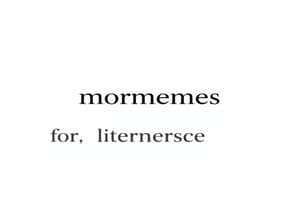Podcast
Questions and Answers
What is the purpose of derivational morphemes?
What is the purpose of derivational morphemes?
- To inflect the base word
- To change the meaning of the word (correct)
- To create past tense forms
- To indicate plurality
The plural inflection in English is typically indicated by adding '-ed' to a noun.
The plural inflection in English is typically indicated by adding '-ed' to a noun.
False (B)
Name one way in which affixes can attach to a word.
Name one way in which affixes can attach to a word.
Prefix, infix, or suffix.
The process of creating a new word by shortening an existing word is called __________.
The process of creating a new word by shortening an existing word is called __________.
Match the inflectional forms with their descriptions:
Match the inflectional forms with their descriptions:
Morphemes are the smallest units carrying ________?
Morphemes are the smallest units carrying ________?
Which of the following words contains three morphemes?
Which of the following words contains three morphemes?
English has become more synthetic over time.
English has become more synthetic over time.
What are the three categories used to describe English morphemes?
What are the three categories used to describe English morphemes?
Which morpheme is an example of a derivational morpheme?
Which morpheme is an example of a derivational morpheme?
The personal plural pronoun in Modern English can be ________.
The personal plural pronoun in Modern English can be ________.
Match the following types of morphemes to their characteristics:
Match the following types of morphemes to their characteristics:
Give an example of a word that consists of three morphemes.
Give an example of a word that consists of three morphemes.
What does the term 'affluenza' represent?
What does the term 'affluenza' represent?
A functional shift occurs when a word takes on a new grammatical function without any change in form.
A functional shift occurs when a word takes on a new grammatical function without any change in form.
What type of word formation blends 'helicopter' and 'gyroscope'?
What type of word formation blends 'helicopter' and 'gyroscope'?
The term 'Flump-flumping' is an example of __________.
The term 'Flump-flumping' is an example of __________.
Match the following linguistic terms with their examples:
Match the following linguistic terms with their examples:
Which of the following is NOT an example of compounding?
Which of the following is NOT an example of compounding?
Alphabatism refers to words that are said as acronyms.
Alphabatism refers to words that are said as acronyms.
What is the process of combining two words to create a new one with a specific meaning called?
What is the process of combining two words to create a new one with a specific meaning called?
Which of the following is NOT one of the lexical categories/parts of speech?
Which of the following is NOT one of the lexical categories/parts of speech?
The indicative mood is used for commands.
The indicative mood is used for commands.
What are the two aspects of verbs mentioned in the content?
What are the two aspects of verbs mentioned in the content?
The __________ form of a verb is used in the imperative mood.
The __________ form of a verb is used in the imperative mood.
Match the following verb forms with their descriptions:
Match the following verb forms with their descriptions:
Which of the following is an example of an inflectional morpheme for nouns?
Which of the following is an example of an inflectional morpheme for nouns?
Adjectives can show comparative and superlative forms.
Adjectives can show comparative and superlative forms.
Name one function of verbs in a sentence.
Name one function of verbs in a sentence.
Which of the following is an example of a demonstrative pronoun?
Which of the following is an example of a demonstrative pronoun?
The primary role of adverbs is to connect clauses and sentences.
The primary role of adverbs is to connect clauses and sentences.
List the five categories of pronouns.
List the five categories of pronouns.
Adverbs can modify verbs and adjectives, but they cannot be placed between _____ and the nouns they modify.
Adverbs can modify verbs and adjectives, but they cannot be placed between _____ and the nouns they modify.
Which type of conjunction is used in the sentence, 'I was thinking that you should study more'?
Which type of conjunction is used in the sentence, 'I was thinking that you should study more'?
Match the type of pronoun with its correct description:
Match the type of pronoun with its correct description:
Indefinite pronouns refer to specific persons or things.
Indefinite pronouns refer to specific persons or things.
Provide an example of a prepositional phrase.
Provide an example of a prepositional phrase.
What is the function of auxiliary verbs in a sentence?
What is the function of auxiliary verbs in a sentence?
The determiner 'most' functions as a possessive determiner.
The determiner 'most' functions as a possessive determiner.
Identify the lexical category of 'that' in the sentence 'I’m sure that guy understands linguistics.'
Identify the lexical category of 'that' in the sentence 'I’m sure that guy understands linguistics.'
The word 'a' serves as a __________ determiner.
The word 'a' serves as a __________ determiner.
Match the types of determiners with their examples:
Match the types of determiners with their examples:
Flashcards
Morpheme
Morpheme
The smallest unit of meaning in a language.
Free morpheme
Free morpheme
A morpheme that can stand alone and have meaning.
Bound morpheme
Bound morpheme
A morpheme that cannot stand alone, but adds meaning to a word.
Derivational morpheme
Derivational morpheme
Signup and view all the flashcards
Analytic language
Analytic language
Signup and view all the flashcards
Synthetic language
Synthetic language
Signup and view all the flashcards
English language evolution
English language evolution
Signup and view all the flashcards
Plural pronoun variations
Plural pronoun variations
Signup and view all the flashcards
Inflection
Inflection
Signup and view all the flashcards
Affix
Affix
Signup and view all the flashcards
Clipping
Clipping
Signup and view all the flashcards
Three ways affixes attach
Three ways affixes attach
Signup and view all the flashcards
Determiners
Determiners
Signup and view all the flashcards
What is the determiner?
What is the determiner?
Signup and view all the flashcards
Auxiliary verbs
Auxiliary verbs
Signup and view all the flashcards
What is the auxiliary verb?
What is the auxiliary verb?
Signup and view all the flashcards
Lexical categories
Lexical categories
Signup and view all the flashcards
Word compounding
Word compounding
Signup and view all the flashcards
Blending
Blending
Signup and view all the flashcards
Functional Shift
Functional Shift
Signup and view all the flashcards
Reduplication
Reduplication
Signup and view all the flashcards
Acronym
Acronym
Signup and view all the flashcards
Alphabetism
Alphabetism
Signup and view all the flashcards
What is the main idea of this content?
What is the main idea of this content?
Signup and view all the flashcards
How does the content illustrate word creation?
How does the content illustrate word creation?
Signup and view all the flashcards
Adverb
Adverb
Signup and view all the flashcards
Adverb Placement
Adverb Placement
Signup and view all the flashcards
Preposition
Preposition
Signup and view all the flashcards
Prepositional Phrase
Prepositional Phrase
Signup and view all the flashcards
Conjunctions
Conjunctions
Signup and view all the flashcards
Pronouns
Pronouns
Signup and view all the flashcards
Types of Pronouns
Types of Pronouns
Signup and view all the flashcards
Noun tests
Noun tests
Signup and view all the flashcards
Adjective tests
Adjective tests
Signup and view all the flashcards
Verb inflections
Verb inflections
Signup and view all the flashcards
Verb syntactic positions
Verb syntactic positions
Signup and view all the flashcards
Tense
Tense
Signup and view all the flashcards
Aspect
Aspect
Signup and view all the flashcards
Voice
Voice
Signup and view all the flashcards
Study Notes
Morphemes
- Morphemes are the smallest units carrying meaning.
Morpheme Examples
- fridge magnets → 3 morphemes (fridge, magnet, s)
- dilapidated → 3 morphemes (di-lapid-ated)
- undoable → 3 morphemes (un-do-able)
Free vs. Bound Morphemes
- Free morphemes can stand alone with meaning (e.g., book, cat, run).
- Bound morphemes cannot stand alone; they must attach to free morphemes to have meaning (e.g., s, un, ed, ing).
Inflectional vs. Derivational Morphemes
- Inflectional morphemes modify a word but do not change the core meaning (e.g., s, ed, 's, ing).
- Derivational morphemes can change the meaning of a word and can create new words with a different meaning (e.g., ful, ness, ly, er, ize, ment).
Inflectional Morphemes in English
- Plural (s)
- Possessive (-'s)
- Past tense (-ed)
- Present Participle (ing)
- Past Participle (-ed)
Affix Attachment
- Prefixes attach before the root.
- Infixes attach in the middle of the root.
- Suffixes attach after the root.
Lexical Category/Part of Speech
- A lexical category is a group of words that share similar grammatical properties and serve similar functions within sentences.
- Examples include nouns, verbs, adjectives, adverbs, pronouns, prepositions, and conjunctions.
Tests: Nouns
- Plural marker (-s)
- Derivational morphemes (-ion, -ism, -ity, -ship, -hood, -er/or, -an, -ist, -age)
Tests: Adjectives
- Comparatives and Superlatives (more, most, -er, -est)
- Derivational morphemes (-al, -able, -like, -ful, -y, -an)
Tests: Verbs
- Inflectional morphology (bare, 3rd person singular, past tense, present participle, past participle).
Verbs: Tests
- Syntactic positions (auxiliary, alone in imperative, subject, subject-object).
Verbs
- Tense
- Aspect
- Voice
- Mood
Tense
- Tense describes when an event/action takes place relative to the utterance.
- English primarily uses past and present tense inflections on verbs.
Aspect
- Aspect describes whether an action is completed (perfective) or ongoing (progressive).
Voice
- Voice describes whether the subject performs the action (active) or is acted upon (passive).
Mood
- Indicative: the default mood for expressing information in a declarative manner in declarative sentences.
- Imperative: used for commands and instructions.
- Subjunctive: used to express wishes, desires, or hypothetical conditions.
Adverbs
- Morphology: Typically ends in -ly.
- Syntactic positions: beginning/end of a clause or after a main verb, but not between adjectives and nouns it modifies.
Prepositions
- Prepositions assist with indicating time, location, duration, manner, etc. and precede noun phrases.
Conjunctions
- Connect words, phrases, and clauses/sentences.
Pronouns
- Personal, interrogative, relative, demonstrative, and indefinite pronouns have different functions in sentences.
Determiners
- Determiners indicate definiteness, quantity, number, and pragmatic functions, always preceding nouns.
Auxiliary Verbs
- Auxiliary verbs come before main verbs or other auxiliary verbs. They do not have the same morphology as standard verbs.
Which "that"
- "That" can be a relative pronoun, a demonstrative pronoun, or a complementizer depending on the context of the sentence.
Morphological Trees
- Break down the structure of a word into its root and affix parts.
Determiners always immediately precede nouns.
- False. Determiners can have adjectives or adverbs in between and still be classified as a determiner.
Which of the following word-class does the underlined word belong to: "I do not know the guy who just went to school."
- Relative pronoun
Which lexical category does the underlined word belong to: "I would like to order this cake, please."
- Determiner (this)
Studying That Suits You
Use AI to generate personalized quizzes and flashcards to suit your learning preferences.




